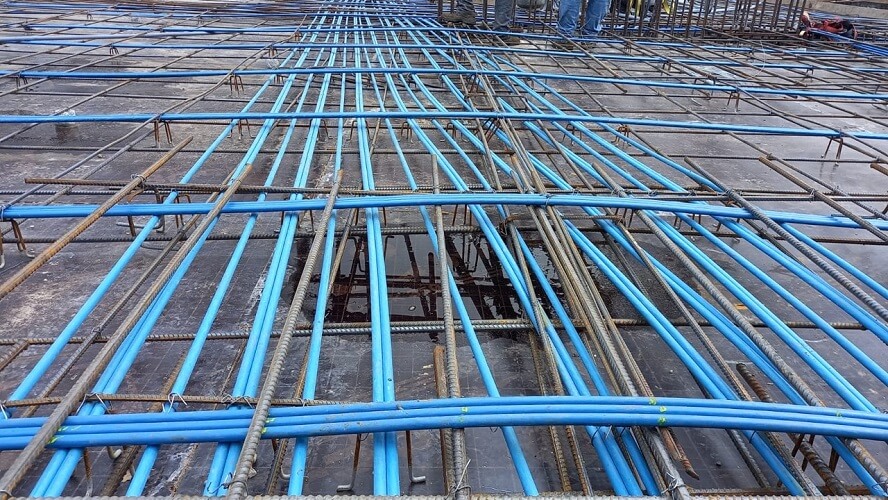There are many changes in construction systems that have occurred over time and concrete slabs are no exception, managing to implement efficiency at the structural level. That is why in this article we will talk about its characteristics and most relevant aspects, told by the expertise of our team of engineers.
Regarding the post-tensioned slabs, we can summarize that they are a construction system composed of high-strength steel, arranged according to a parabolic configuration, previously analyzed, and designed by a structural engineer, considering the use of the particular structure.
It is through cables inside the concrete, which are anchored by means of wedges to their anchors (live or dead) at the ends of the slabs and, subsequently, are subjected to a determined tension. This procedure is called slab tensioning where internal pre-stresses are induced, opposite to the application of the loads and that helps to minimize the effect when loads are exerted on the slabs and it is executed, once the control laboratory of quality, validates the minimum design resistance of the concrete, required according to plans. This resistance is expected after three days.
At Mar Azul, our inspection service is in charge of verifying and validating each process at the time of tensioning and, before the laboratory provides and delivers the concrete resistance, information obtained at the time of taking the corresponding concrete sample. when pouring each slab. Within the revisions that are carried out, another very important one is the calibration of the equipment; Once reviewed and complied with, authorization is given to proceed with the tensioning.
A post-tensioned system can be used for commercial, residential buildings, foundation slabs, parking decks, and other industrial uses.
There are many benefits of post-tensioned slabs. We will share three that we consider provide great value and we will review them in a comparative way to the traditional system, such as a reinforced slab:
Initially, a post-tensioned slab significantly reduces construction times, since after three days when the tensioning has been completed, the slab can be stripped. A reinforced slab approximately requires a one month waiting period to be able to strip the slab.
As a second benefit, we can highlight that the structure is much lighter, also allowing the slab to be thinner, which directly impacts both savings in concrete and in the amount of steel, in addition to allowing greater spans, lights or spaces between supports. In a reinforced slab, its weight is greater, both due to the amount of steel and the required amount of concrete, and the spans cannot maintain as much distance as in a post-tensioned slab.
And, as a third point, the reinforced slab also provides greater design flexibility. Unlike a reinforced one, which requires more analysis for slabs with less traditional shapes.
Additionally, when purchasing the cables, it is important to take into account that they must comply with what is specified in the plans and with the respective certifications of the product, according to standards, in order to be sure that we are selecting quality materials. Similarly, for the installation, companies with previous experience must be used and, therefore, verify that all the equipment is in good condition and properly calibrated with their corresponding calibration certifications.
Reducing the natural cracking of the concrete, savings in materials, and greater spans between supports are examples of benefits that we can obtain through the use of post-tensioned slabs, and this, in turn, allows structural improvement; a real evolution as far as slab options are concerned.



return
share in:
return
share in:
return
share in:
Recommended reading
Getting to know Carlos Gonzalez
Jun
Importance of having an expert advisor in finishes
Jun
How to define if your project is feasible?
May
Efficiencies in earthworks
May
Getting to know Aura Quintana
Apr
Project permits
Apr
Leap to technology: integration and efficiency
Mar
What is a Test Fit?
Mar
Getting to know Jonahan Castillo
Feb
Importance of involving an electromechanic in a project
Feb
Sofitel Legend Casco Viejo, a unique experience in Panama
Jan
Our 2022 summary
Jan
Getting to know Digna Olivardia
Dec
Our experience with post-tensioned slabs
Nov
The different phases of the design service at Mar Azul
Nov
Multifunctional spaces
Oct
Getting to know Salomón Dayán
Oct
Importance of a proper technical inspection
Sep
Which sustainable certification to choose and which is the most suitable for my project?
Aug
Hotel La Compañía, our execution experience in an important historical area
Aug
Getting to know Leydis Moreno
Jul
Cost management
Jul
Responsible recycling
Jun
Welcome Back Engineer José Ramón Icaza
Jun
Getting to know Jorge Silva
May
Five steps to create a project plan
May
Recommendations for working with natural stones
Apr
Administration vs. Project management
Apr
Getting to know Teresa Perez
Mar
Five common mistakes in the installation of lightweight walls and how to avoid them
Mar